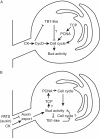Auxin, cytokinin and the control of shoot branching
- PMID: 21504914
- PMCID: PMC3091808
- DOI: 10.1093/aob/mcr069
Auxin, cytokinin and the control of shoot branching
Abstract
Background: It has been known for many decades that auxin inhibits the activation of axillary buds, and hence shoot branching, while cytokinin has the opposite effect. However, the modes of action of these two hormones in branching control is still a matter of debate, and their mechanisms of interaction are equally unresolved.
Scope: Here we review the evidence for various hypotheses that have been put forward to explain how auxin and cytokinin influence axillary bud activity. In particular we discuss the roles of auxin and cytokinin in regulating each other's synthesis, the cell cycle, meristem function and auxin transport, each of which could affect branching. These different mechanisms have implications for the main site of hormone action, ranging from systemic action throughout the plant, to local action at the node or in the bud meristem or leaves. The alternative models have specific predictions, and our increasing understanding of the molecular basis for hormone transport and signalling, cell cycle control and meristem biology is providing new tools to enable these predictions to be tested.
Figures



References
-
- Arite T, Iwata H, Ohshima K, et al. DWARF10, an RMS1/MAX4/DAD1 ortholog, controls lateral bud outgrowth in rice. The Plant Journal. 2007;51:1019–1029. - PubMed
-
- Balla J, Kalousek P, Reinohl V, Friml J, Prochazka S. Competitive canalization of PIN-dependent auxin flow from axillary buds controls pea bud outgrowth. The Plant Journal. 2011;65:571–577. - PubMed
-
- Bangerth F. Response of cytokinin concentration in the xylem exudate of bean (Phaseolus-vulgaris L) plants to decapitation and auxin treatment, and relationship to apical dominance. Planta. 1994;194:439–442.
-
- Bennett T, Sieberer T, Willett B, Booker J, Luschnig C, Leyser O. The Arabidopsis MAX pathway controls shoot branching by regulating auxin transport. Current Biology. 2006;16:553–563. - PubMed
Publication types
MeSH terms
Substances
Grants and funding
LinkOut - more resources
Full Text Sources
Other Literature Sources

